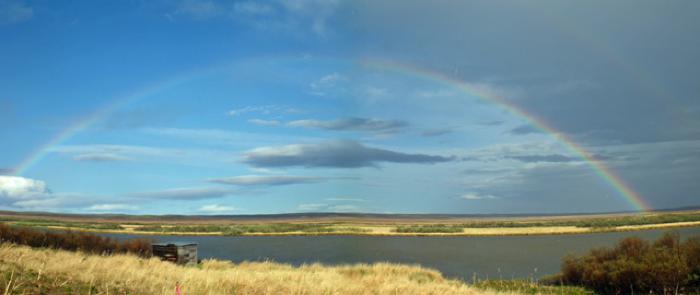Rainbow — ARatukaq (N), Puwisaq (S)

Combine sunshine and raindrops and the result is a luminous arc of colors commonly known as a rainbow. This vivid display of light has a prominent place in the beliefs of many cultures. Some people see the rainbow as lucky, or as a sign of an important, upcoming event. In some spiritual traditions, the rainbow signals the birth of a baby and the reincarnation of a recently passed soul. Others consider rainbows to be divine. The Norse believed that rainbows were a bridge to the world of the gods. Among Australian Aborigines, the rainbow is a serpent that battles the sun to replenish Earth’s essential water.
Alutiiq people use several words for rainbow. ARatukaq, a word derived from Russian, comes from the northern subdialect of the Alutiiq language. Puwisaq comes from the southern subdialect and also means belt.
The word puwisaq also refers to the strip of cloth or ribbon that Orthodox godparents once gave to babies at baptism. This piece of fabric was usually white with an embroidered cross and was worn over the chest – between a person’s shirt and undershirt. For Easter, people wore brightly colored versions on the outside of their clothing. These puwisat were worn across the body like a sash and knotted around the waist. One Elder remembered that when an honored person died, their death shroud would be torn into strips to use as puwisat for the community’s next generation of babies. Historically, people wore puwisat all the time, but only a few Elders still have their baptismal band stored away.
Elders report that rainbows are sometimes called, Puwisiim Maman lintaa - literally the Virgin Mary's puwisaq cloth. When the faithful see a rainbow, they make the sign of the cross, as a sign of respect and remembrance for the Virgin Mary.
